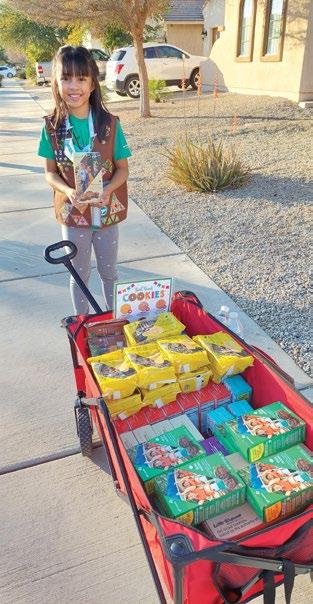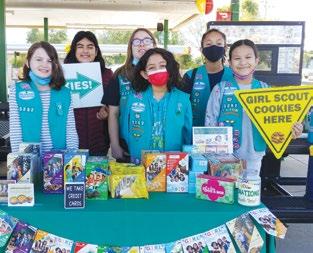
4 minute read
Kids’ Corner It’s Girl Scout Cookie Season!



How to support the largest girl-led entrepreneurial program in the world.
Each year, Girl Scouts in Arizona participate in the largest girl-led entrepreneurial program in the world: The Girl Scout Cookie Program. And this year it is not only bigger and better than ever, but longer as well. For the Girl Scouts–Arizona CactusPine Council (GSACPC), the local cookie season takes place for seven full weeks from Jan. 16 to March 5.
“As in years past, all Girl Scout Cookie proceeds stay local to help girls fund impactful projects to benefit the community; embark on amazing girl-led troop adventures; provide programs in STEM, the outdoors, life skills and entrepreneurship; maintain and improve four camp properties; and provide financial assistance that keeps Girl Scouting available and affordable for all girls,” says Mary Mitchell, co-CEO of GSACPC.
“We extended our cookie season by one week to support girls interested in selling our new, limitededition Raspberry Rally cookie, as Feb. 27 is the earliest date the flavor will be available for shipping from our baker. Now our community has more time to support girls and stock up on their favorite cookie only be sold online from Feb. 27 to March 5, while supplies last.
New Financial Literacy Badges
Girl Scouts’ newly updated Financial Literacy badges offer entrepreneurial playbooks for every age level. From the Cookie Goal Setter badge earned as a Daisy to the Entrepreneur Accelerator for girls in high school, the Girl Scout Cookie Program teaches girls financial literacy, planning, budgeting, teamwork, innovative thinking, and confident decision making.
GIRL SCOUT COOKIE NIGHT, DEVIN BOOKER BUS AND PATCH REVEAL WITH THE PHOENIX SUNS
BRING HOME THE COOKIES 5K RUN/WALK –FEB. 25
Join GSACPC and State Forty Eight Foundation, for the second Bring Home the Cookies 5K Run/Walk on Feb. 25 at Westgate in Glendale. The family-friendly event, open to Girl Scout families, competitive runners, walkers, and the community at large, will start and finish at Westgate and feature music, food, and cookie booths. All registered participants will receive a Girl Scout goodie bag with a State Forty Eight branded 5K shirt, a package of Girl Scout Cookies, a medal, and more!
To register for the 5K, visit girlscoutsaz.org/5k and for more information on the local Girl Scout Cookie Season, visit girlscoutsaz.org.
flavors,” says Christina Spicer, co-CEO of GSACPC. In addition to the extended sale dates, here is a snapshot of everything as it relates to the 2023 cookie season across Central and Northern Arizona:
New Raspberry Rally
Raspberry Rally – will join the nationwide lineup for the 2023 Girl Scout Cookie Program. A thin, crispy cookie infused with raspberry flavor and dipped in a delicious chocolaty coating, this must-have new cookie is first in the Girl Scout Cookie lineup to be exclusively offered for online direct shipment only while supplies last, enhancing girls’ e-commerce sales and entrepreneurial skills. Please note this cookie will
On Jan. 22, hundreds of Girl Scouts descended upon Footprint Center to collectively cheer on the Phoenix Suns in their showdown against the Memphis Grizzlies. Beyond that, as the game ended, dozens of Girl Scouts took over the plaza outside Footprint Center to sell cookies as well as REVEAL their new Girl Scout Devin Booker Bus. Even better? The local Girl Scouts also created a custom patch to commemorate the partnership, which they unveiled at the event.
“The minibus, made possible by a Devin Booker Starting Five $100,000 grant, will be used to transport girls to and from educational and character-building activities and experiences. Due to vandalism and theft of its prior vehicle, GSACPC had no way to transport girls to programs and events. The lack of transportation often meant that girls would not have an opportunity to participate in activities,” says Mitchell.
Whenyou give a flower a drink of water, where does the water go? My daughter and I recently investigated this very question, and thought it would be a fun way to combine science while making some custom colored flowers for Valentine’s Day.
HERE’S WHAT YOU NEED:
• 1 dozen white flowers (carnations work really well)
• Water
• Vase
• 4 glasses or larger cups
• Knife/box cutter
• Food coloring (multiple colors)

DIRECTIONS:
1. With an adult’s help, trim your flowers to a workable length, and ensure they are trimmed at an angle. Keep all your flowers in plain water until you are ready for the next step.
2. Together with your adult, use the knife to split three of the flowers straight down the center. Return to water for now.
3. Fill four glasses with water and up to 20 drops of food coloring. Each glass should have a different color of water.
4. Line up the cups next to each other and, using your split-stem flowers, place flowers straddling the cups so one side of stem is in one color, one side is in another.
5. Place one non-split flower in each cup of colored water, too. Leave the rest of your flowers in the plain water as a control.
6. Leave all flowers to sit for two to five days and make observations along the way! This is a good chance to make some predictions: what will happen to the flowers in colored water? Will the colors mix? Which colors will you see in the flowers first?
WHAT’S HAPPENING?
What did you notice about the flowers? Did any of your predictions come true? Take a look at the leaves, too—what do you notice? There’s some very cool science happening here. Flowers “drink” water almost like you would drink water through a straw. The flowers take up water through thin tubes called xylem in a process called capillary action. As water evaporates from the leaves and petals of the flower (known as transpiration) and creates a low pressure system, more water is drawn up through the tubes because water molecules like to stick together (this is called cohesion). The dye in the water travels up the tubes, too, but doesn’t evaporate, so it remains in the leaves and petals. Splitting the stems allows us to see how the tubes are dispersed in the flower stem, and where they end. Try splitting your flower stem into thirds or swapping colors of dye after a few days. What happens then? Happy experimenting!
Sari Custer is a lifelong science junkie, and the Chief of Science and Curiosity at Arizona Science Center. In addition to serving as the public spokeswoman for the Science Center, Sari is also host of the video series, Sari on Science which fosters excitement about science for viewers of all ages.






